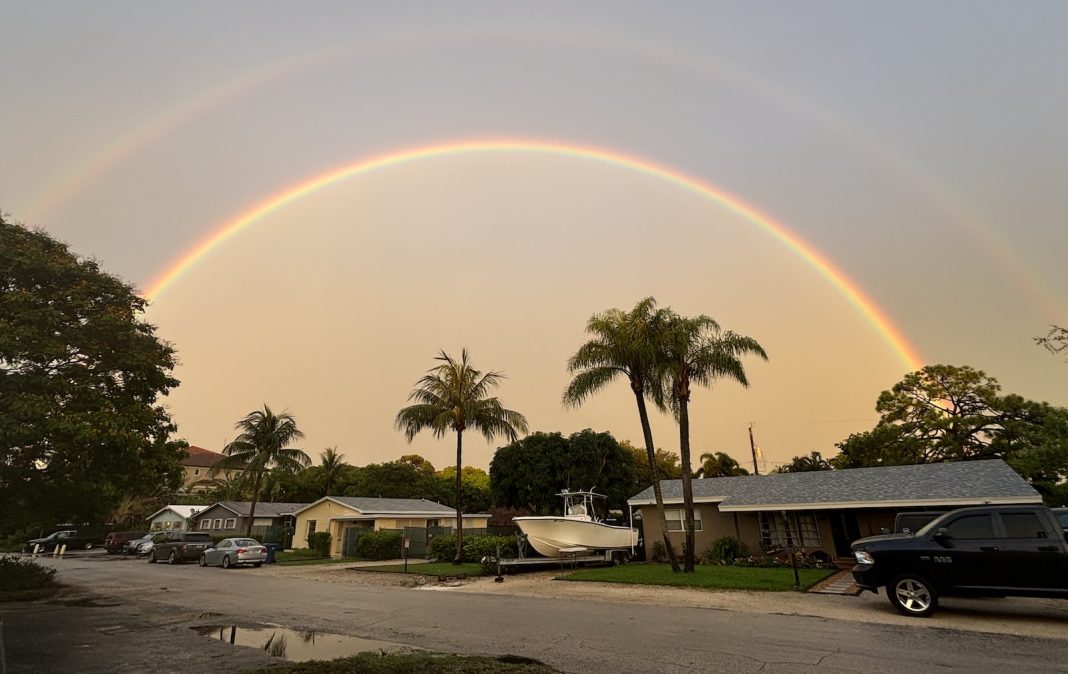The Miami-Fort Lauderdale area was thrown into flood-induced chaos on Wednesday as a persistent rain band south of the disturbance Invest 90L brought 10 to 20 inches of rain to some areas. Localized heavy rains were still a threat in South Florida on Friday, while 90L has a slim chance of becoming a tropical cyclone this weekend as it races into the northwest Atlantic. Next week, a much more prolonged and potentially serious setup will take shape in the western Gulf of Mexico.
At midday Friday, 90L was located about 100 miles southeast of the Outer Banks of North Carolina. The weak system, with a central pressure of around 1008 millibars and top sustained winds of around 35 mph, was shuttling northeastward along a stationary front. 90L was embedded in a moist atmosphere. Sea surface temperatures ahead of 90L’s path along the Gulf Stream were unusually warm for mid-June, around 26 degrees Celsius (79 degrees Fahrenheit), but only marginal for tropical development. Fierce wind shear of 30 knots will drop to around 20-25 knots on Saturday, but it’s still unlikely 90L will develop further before it accelerates over much colder water. In its Tropical Weather Outlook issued at 2 p.m. EDT Friday, the National Hurricane Center gave 90L only a 10% chance of development in the two- and seven-day periods.
A persistent surface boundary extends southwestward from 90L into the western Gulf. Moist low-level winds south of this boundary were still funneling ample moisture across South Florida, and pockets of very heavy rain could develop into Saturday before the area transitions into a more typical summer-shower-and-thunderstorm regime.
Thursday brought widespread three- to eight-inch rains to the southwest Florida coast and the Key West area, with one to two inches totals in the Miami-Fort Lauderdale area on top of Wednesday’s epic deluge. Fort Lauderdale International Airport racked up 9.54 inches of rain on Wednesday, its third-highest total for any day in 79 years of record-keeping. The all-time daily record of 22.5 inches was set just 14 months ago, on April 12, 2023. Some three-day totals in southeast Florida topped 20 inches.
A Central American Gyre could spawn one or more tropical cyclones in the second half of June
The term du jour for the next few days of tropical weather watching is the Central American Gyre. Most common in the early and late parts of hurricane season, the gyres — a type of monsoon low — are weak but sprawling areas of surface low pressure that can persist for two weeks or more across Central America and adjacent parts of the Atlantic and Pacific, including the western Caribbean and southwest Gulf of Mexico. They are most common in May, June, September, October, and November.
The gyres often spin off smaller circulations that can become full-fledged tropical cyclones. The GFS and European model ensembles remain in strong agreement that one such spinoff low may develop early next week in the southern Gulf of Mexico’s Bay of Campeche, then move onto the coast of northeast Mexico around midweek. In its 2 p.m. EDT Friday outlook, the National Hurricane Center gave this area a near-zero chance of development through Sunday but a 50% chance for the seven-day period. Very warm sea surface temperatures and the circulation-inducing geography of the Bay of Campeche will support development, and there are signs that an upper high could build over the area, reducing wind shear and lending additional support. How strong such a system could get will likely hinge on how close to land any center forms and in turn how much time that allows for over-water motion before an ultimate landfall.
If a more northward center develops — as suggested by some ensemble members from the 12Z Friday run of the European model — it would have more time to gather strength and could end up making landfall a few hundred miles south of the Mexico-Texas border, bringing heavy rains to South Texas. In the longer range, there may be one or more additional tropical threats hiving off from the Central American Gyre into the Gulf of Mexico from later next week into the following week.
However it evolves, the flow around the Central American Gyre and any spinoff lows will push a moist air mass toward the northwest Gulf, leading to a steadily increasing chance of heavy rain along the coasts of Texas and Louisiana. The gyre will also pull moisture into the Pacific coast of Central America and Mexico, leading to potentially dangerous flooding there.

Life-threatening rains coming to the Pacific coast of Central America and Mexico
Over the coming week, the counterclockwise flow of air around the Central American Gyre will pull copious moisture over Central America and southern Mexico from portions of the Eastern Pacific where water temperatures are about 1 degree Celsius (1.8°F) above average. Most of Central America and Mexico experienced their hottest spring (March-May) on record, heating up the surrounding waters to record levels. These record-warm waters will be able to supply a record amount of moisture to the atmosphere. This moisture-laden air will be forced upward by the high terrain along the coast, resulting in torrential rains along the Pacific coasts of El Salvador, Guatemala, and southern Mexico. Prodigious life-threatening rains of 14-30 inches are predicted for this region over the next seven days by both the GFS and European models (Fig. 1).
We help millions of people understand climate change and what to do about it. Help us reach even more people like you.


